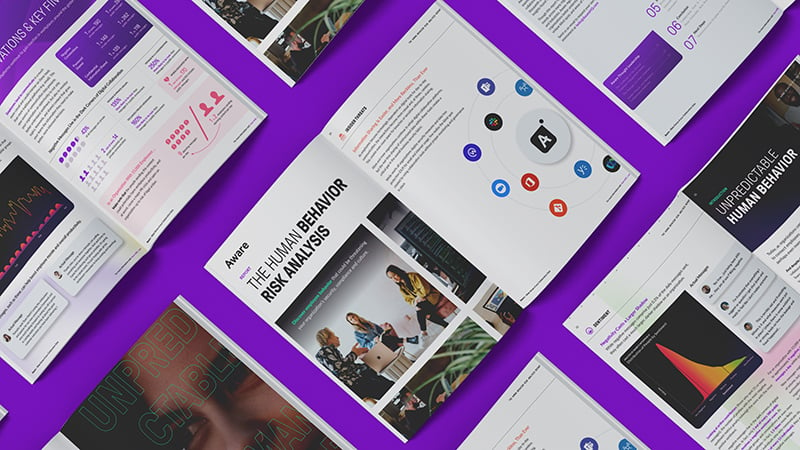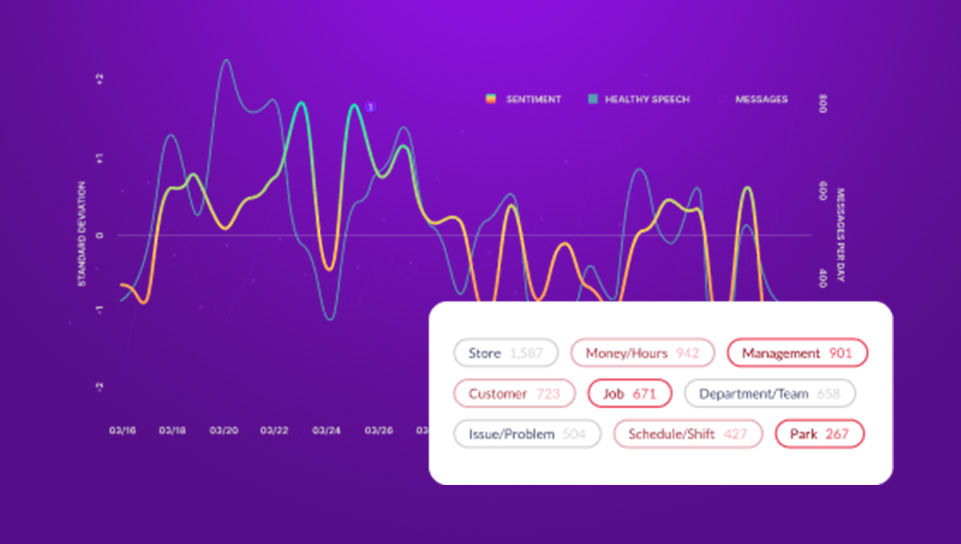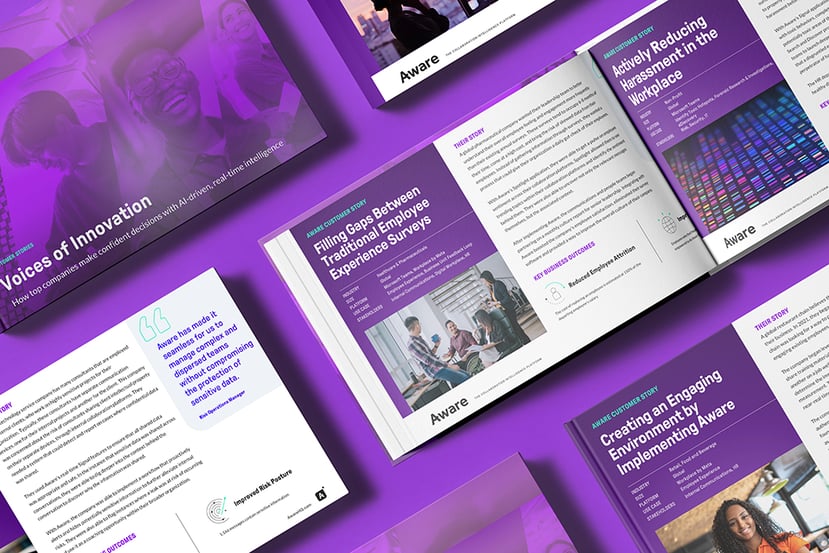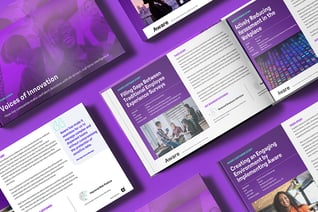DLP Monitoring: What It Is and Why You Need It
by Aware
Data loss prevention (DLP) is the process of protecting sensitive data from misuse, exfiltration, theft, and loss. DLP strategies involve tracking data through an organization’s network and making sure only authorized users can access the data for reasons that make sense.
What is data loss prevention monitoring?
DLP monitoring involves continuously scanning the organization’s data and maintaining visibility over the activities of employees where they occur on devices, in the cloud, and across network systems. This helps identify anomalous or suspicious behavior and surface risks before data loss occurs. DLP monitoring helps companies enforce their data handling policies in real time.
Contents
- Examples of DLP threats
- What are the challenges of DLP?
- What are the benefits of DLP?
- Common DLP tactics to prevent data breaches
- What kinds of tools are used for DLP monitoring?
- DLP monitoring at work: practical examples in the real world
- How Aware simplifies DLP monitoring for you
Examples of DLP threats
It’s not only important to know how data moves through an organization, but also what sorts of threats to watch for. The following are some common threats to an organization’s data:
- Ransomware—This malicious software encrypts files to make them inaccessible to the victim. The hacker then demands a ransom payment to turn over decryption keys for the company to regain access. Significant data loss is possible if the affected files aren’t backed up or the ransom isn’t paid.
- Phishing—A social engineering method involving attempts to trick end users into giving away sensitive information. Some phishers masquerade as trustworthy sources and gain access through users clicking the phisher’s link disguised as a legitimate business. Successful phishing scams result in data breaches and lead to unauthorized access to data.
- Insider risks—Individuals within an organization can be threats, too. Employees, contractors, or partners with legitimate access to data may share information where it shouldn’t be shared. It can be intentional via malicious insiders (e.g., stealing), or accidental (e.g., through negligence or lack of knowledge).
- Cyberattacks—Bad actors use cyberattacks to gain access to systems and networks through hacking, exploiting software vulnerabilities, distributed denial-of-service (DDoS) attacks, and SQL injection. Hacking techniques evolve all the time and result in data loss damages sometimes in the millions from a single attack.
- Malware—This is a broad term that includes many kinds of software intended to disrupt computer operations or gain unauthorized access. Some examples are worms, viruses, spyware, adware, or Trojans.

Whitepaper: Six critical digital workplace security risks you should know about
What are the challenges of DLP?
During the implementation of DLP strategies, companies may experience some obstacles. We’ve gathered a few of the more common challenges to help with planning.
Diverse data distribution
Multiple data types across a diverse landscape of network locations can present challenges for DLP monitoring. Traditional tools don’t always provide comprehensive protection for structured and unstructured data across endpoints, cloud services, and on-premises infrastructure. These blind spots may leave organizations open to data loss.
Complexity of policies complicate collaboration
Data must have restrictions that limit access to its users. However, when these rules are overly restrictive, they can n disrupt daily business dealings. The challenge is finding a good balance of security policies, permissions, and productivity.
Wasting time and resources with false positives
Legacy DLP solutions may not be able to analyze or understand the full context when a policy is triggered. They may also rely too heavily on rules that aren’t kept updated. Responding and investigating these alerts can drain your security team’s time and resources.
Updating governance and compliance regulations
DLP policies need to be updated whenever changes happen to governmental or industry regulations to avoid regulatory violations and fines. Internal policies must evolve, along with training to keep employees abreast of these changes.

Webinar: Your legal ops checklist for collaboration security
What are the benefits of DLP?
Protecting data against loss has significant benefits that outweigh the challenges, particularly considering the value of data in today’s modern business environment. Some of the biggest benefits are:
- Control over the data—DLP strategies give companies better control by removing blind spots regarding sensitive data. Companies that define policies on how their data is handled, including where it’s stored, who has access, and how the data is used can help prevent unauthorized use, transfers, or misuse of their sensitive information.
- Improved data visibility—DLP monitoring improves visibility of where data moves across an organization’s workflows, including locations, transfers, and access. This can reveal potential risks and allow the organization to minimize them.
- Protected intellectual property and sensitive data—Intellectual property, trade secrets, and other confidential data are critical components of sensitive data. DLP monitoring can detect and block attempts to breach security that lead to data leaks or theft of this crucial asset.
- Compliance adherence—In highly regulated industries subject to regulations like HIPAA, GDPR, or PCI-DSS, DLP monitoring helps companies enforce data handling policies, provides audit trails, and prevents data sharing that breaks compliance protocols.
- Lower risk of fines and data breach costs—With effective DLP monitoring to protect regulated data and maintain compliance, organizations can minimize their risk exposure and reduce the chances of costly fines for non-compliance or data breaches. This can result in significant savings by avoiding violation penalties and lawsuits.
- Suspicious activity detection and monitoring—DLP tools capable of monitoring data in storage, in motion, and wherever it’s being used enable companies to detect and flag suspicious or unauthorized behaviors that may lead to data loss or leaks. Companies can then act promptly to mitigate any threats that arise.

Whitepaper: Collaboration data governance for IT and Security leaders
Common DLP tactics to prevent data breaches
Data breaches disrupt business and erode trust with customers, damaging an organization’s reputation. Preventing them is a priority wherever possible, and there are key DLP strategies that can help.
- Encrypting data in transit and at rest. Whether the data is stored or in transit, encrypting it is a smart DLP strategy because it renders the data unreadable to unauthorized users. Even if the data is intercepted, its contents are secure.
- Classifying data by sensitivity level. Knowing how sensitive certain data is allows DLP software to prioritize cybersecurity controls and handling procedures for the data in a hierarchy. Companies can restrict access and monitor usage of the data appropriately and set data handling policies according to its data classification.
- Training for data security awareness. Implementing regular data security awareness training for employees is essential for effective DLP monitoring. An educated workforce understands and adheres to data handling best practices, and they can identify threats such as phishing scams or multi-factor authentication fatigue attacks. Workers will also know what protocols to follow when faced with threats to prevent breaches.
- Machine learning and UEBA. Today’s DLP solutions leverage machine learning and user and entity behavior analytics to develop baseline activity patterns. Once typical behaviors are established, DLP monitoring will alert when anomalies are present, giving companies time to respond proactively, before a leak or insider threat is fully realized.
- Monitoring data flows. Through DLP monitoring, organizations can follow their data throughout their network, cloud services, and all endpoints to surface unauthorized data sharing. No matter where the data is, if it’s in motion, or if it’s being used or stored, it’s under observation and therefore more secure.
- Implementing access controls. Granular access controls and the principle of least privilege are key DLP tactics. By giving only authorized individuals and systems the amount of required access to sensitive data, the risk of data breaches or leaks is markedly reduced.
- Maintaining audit trails. With detailed audit trails and logs of data access, usage, and transfers, companies can use their DLP monitoring strategies as an aid in incident response, remediation, investigations, forensic analysis, and proving compliance with regulatory agencies.
What kinds of tools are used for DLP monitoring?
The right DLP tools can mean multi-layered data protection no matter where the data assets are in an organization’s enterprise infrastructure. Here are common DLP tools that support data protection efforts.
- Network DLP tools—Monitor data in motion through the corporate network, including web traffic, email, and file transfers. These tools detect and block unauthorized data transmissions, filter data streams, and help enforce DLP policies in collaboration communications.
- Endpoint DLP tools—Cover data on user devices like desktops, laptops, and mobile devices. Activities like copying data to removable media, uploading to the cloud, and printing sensitive files are tracked and can be restricted or blocked altogether, depending on company policies.
- Email DLP tools—Specifically monitor all email communications for sensitive data leaving the organization through this channel. These tools can redact, quarantine, or block emails with content that violates DLP policies.
- Cloud DLP tools—Protect critical data stored in the cloud for SaaS applications like Google Workspace, and collaboration platforms like Slack, Workplace from Meta, or Microsoft Teams. These tools monitor cloud activity and data handling for policy violations, preventing unauthorized data sharing or leaking.
- Data discovery tools—Locate and identify sensitive data across a company’s infrastructure, including file shares, cloud storage, databases, etc.
- User behavior analytics—Develop a baseline of user behavior patterns using machine learning models so that when anomalies occur that indicate insider threats, compromised security, or potential malicious data exfiltration, procedures can be implemented to reduce risk.
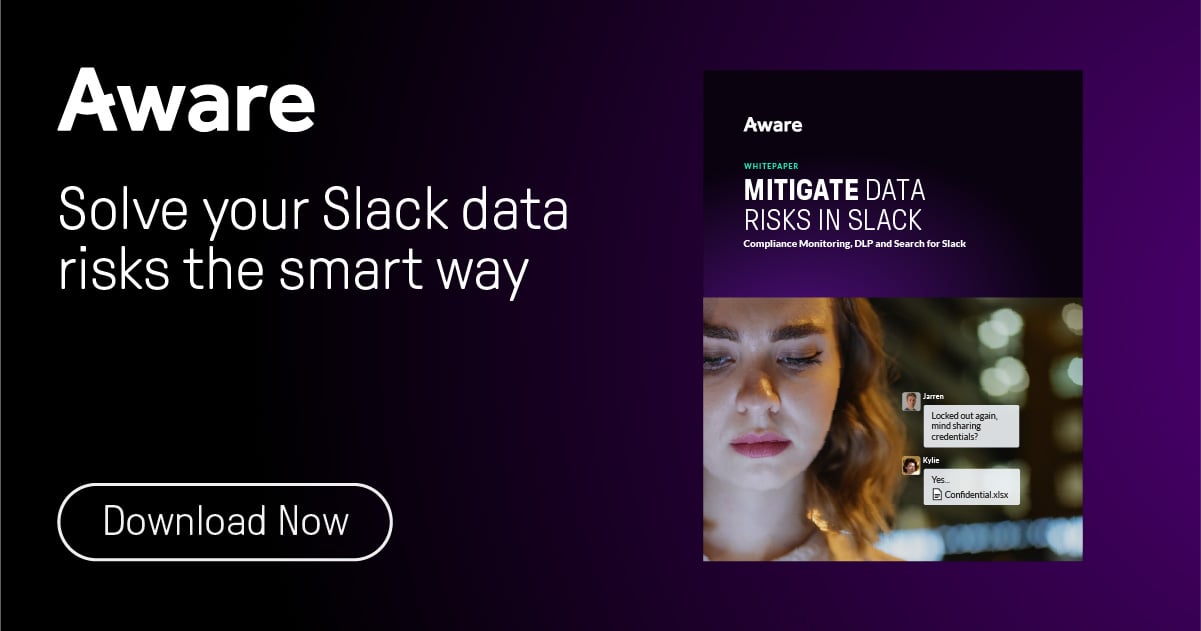
Mitigate data risks in Slack with this simple guide
DLP monitoring at work: practical examples in the real world
Keeping video game content confidential
For global video game companies, new game content is incredibly valuable intellectual property. A data leak of this sensitive asset would be highly detrimental. For one company, external users in collaboration spaces created the risk of confidential game content being shared prematurely with the public before the company was ready.
The company used DLP tools from Aware to prevent data leaks. They did so by segmenting collaboration users, including the external users, into platform groups, and monitoring the data for key terms or images being shared between those groups. The capability to surface the context of these communications minimized risks, and in the instance of a data leak, the designated department could quickly pinpoint the context to resolve internal investigations.
Protecting trademarked data
Trademarked data is another important form of intellectual property. When a large utility provider acquired another company, they discovered differences in their DLP policies regarding data handling. The infosec team expressed a need for alignment between the two companies as they merged into one, particularly when it came to the sharing of sensitive trademarked data.
The utility company integrated Aware with the company’s systems and begin capturing conversations in collaboration platforms that could contain sensitive data. The infosec team used rules to flag keywords, images, and files with context to examine what was being shared. From there, they were able to redefine acceptable use policies for data handling so both merging parties could perform their duties in a compliant manner. Today, the information security department has increased confidence that the trademarked data shared across their platforms is secure.
Identifying and protecting sensitive data in telecoms
During their first Slack rollout, a major telecommunications company enlisted Aware to help them surface risks within employee messaging on the platform. What they discovered was a truly eye-opening level of personally identifiable information (PII) and payment card industry (PCI) data posted by call center employees due to the complexity of the system in place for handling PCI.
Understanding the gravity of each instance of customer personal data stored in Slack—and the potential regulatory violation and possible fine—the company reconfigured its program access and data handling policies, making employees’ system access more conducive to a productive work environment. This solution allowed them to correct the issue and retrain employees on acceptable use of sensitive data to maintain compliance. Using Aware, the company surfaced and remediated more than 20,000 credit card number shares in the prior 12 months.
Safeguarding historical data with retention rules
Local regulations required an international bottling company to purge all the direct messages and chat data within the company’s collaboration platform every 30 days. However, their system controls couldn’t distinguish between chats and data that lived in public channels. Every 30 days, they were losing valuable historical context.
With Aware, the company set granular rules for records retention to safeguard data from different platform channels, sources, and more for different timeframes. This helped the company preserve institutional knowledge while remaining within compliance with local requirements.
How Aware simplifies DLP monitoring for you
Collaboration tools give organizations the flexibility and efficiency essential to keeping up in today’s business environment. With Aware, companies can reduce risks within these collaboration platforms that threaten their data security. With DLP monitoring tools purpose-built for collaboration datasets, Aware’s proprietary technology and AI models provide protection for sensitive data from unauthorized access or data leakage.
- Save time and resources by returning fewer false positives. Our natural language processing is trained exclusively on short-form collaboration messages, so the Aware platform understands nuance with near-human accuracy.
- The Enable IT and security teams with the capability to set granular rules and policies to track violations.
- Automate alerts to address violations with proactive employee coaching before data mishandling becomes a regulatory compliance violation.
- Preserve the content surrounding a violation so critical context is included in an investigation.
- Use role-based access controls (RBAC) and audit trails to limit visibility into sensitive content surfaced by DLP workflows.
- Understand where user behaviors are more likely to deviate from policy and implement solutions that limit and lower reliance on shadow IT.
Are you ready to take the next step for DLP monitoring? Request a demo today!
